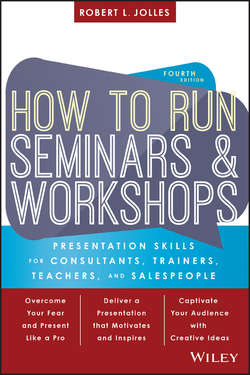Читать книгу How to Run Seminars and Workshops - Jolles Robert L. - Страница 9
На сайте Литреса книга снята с продажи.
PART I
GETTING STARTED
CHAPTER 1
CREATING A SEMINAR BUSINESS
Keynotes
ОглавлениеWhen people think of professional speakers, often they think of keynote speakers, who give presentations that are typically delivered in an hour-or-less time frame, and often to larger audiences. With larger audiences and that short of a delivery time, it's pretty difficult to create change on a deep, cultural level. Often the expectations of these types of audiences typically can be summed up this way: “If I can learn one or two good ideas from this presentation, I'll be happy.”
When I first left Xerox, I swore I would never conduct a keynote presentation. After all, I came from what I had always felt was the Green Berets of speakers, Xerox – the greatest trainers on earth. We didn't necessarily walk into a room to speak to teach you one or two good ideas to motivate or make you feel better. We taught repeatable, predictable techniques that required fairly lengthy workshops. To talk to a group for an hour and call it training was ridiculous in our eyes.
My first year in business, I frequently was asked to deliver keynote-type presentations. I declined. There was no way I was going to give in and compromise my materials. Then one day a new client successfully persuaded me to deliver such a presentation by asking me what I normally got paid and offering to double it. A keynote speaker was born.
It didn't take me long to fall in love with this style of delivery. Not only was the money good, but the wear and tear on my body was a lot less. Which would you prefer: spending a couple of days on the road and speaking for eight or more hours, or getting up early, blowing into town, taking a limo to and from your speaking site, and making it home for dinner? I fell in love with this rock star existence, and who wouldn't? Then in 2002, the stock market corrected, the economy turned, and the speaking industry changed with it.
Those speakers who made a living giving keynotes and motivating audiences for an hour suffered, with many going out of business. In a sense, the herd was thinned a bit. Those speakers who remained in business were forced to adapt to a new way of working with clients, and keynote-type deliveries fell out of vogue. Within a few years the industry crawled back to life, and in 2008, as the market dropped, the herd thinned once again. The industry came back to life once again within a few years, and so it goes.
Does that mean you should never deliver a keynote? Of course not! Just understand what a keynote is and is not. A keynote is not a seminar. It's not a workshop, and it will not create the cultural change many companies are looking for. However, keynotes will do something else that makes them very valuable. They sell seminars.
My clients call the one-hour speaking engagements that I deliver “keynotes.” I call them “sales calls.” When I introduce myself to an organization and the company also gets to know my company and my services, I can add value to that company. That's a home run. In my mind, the keynote becomes the appetizer to creating a more realistic approach to training and to establishing a long-term relationship.
